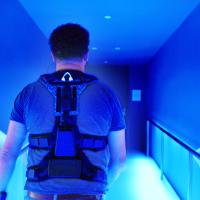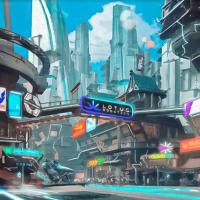Theme parks have long offered immersive experiences. From the Hollywood nostalgia of Universal Studios to the cosmopolitan adventures of Epcot, theme parks provide a portal out of everyday life and into new worlds. But evolving technologies are forcing parks to kick it up a notch.
Consumer tech — namely, video games and virtual reality applications — has gotten so sophisticated that people can have immersive entertainment experiences without ever leaving their homes. To meet rising expectations and remain relevant, theme parks are investing millions into virtual and augmented reality technologies.
The future of theme parks is bound to include digital worlds. VR theme park experiences are already adding a new dimension to an industry that’s long relied on 20th-century technology. And it’s possible that some VR theme parks won’t have a physical location at all.
The evolution of theme parks
VR isn’t exactly new to theme parks. In 1998, Disney launched DisneyQuest, which included two early VR experiments: Aladdin’s Magic Carpet Ride and Ride the Comix. Unfortunately, both attractions caused guests motion sickness.
Since the 2010s, VR technology has grown far more sophisticated and affordable. In 2015, Europa-Park in Germany became the world’s first theme park to incorporate a VR experience into an existing roller coaster called the Alpenexpress Enzian. The coaster offers riders the option of wearing wireless Samsung Gear VR headsets, each of which displays one of four unique experiences.
Other parks soon followed suit. A 2018 study found that about 30% of European manufacturers of steel roller coasters had already made VR additions to one or more of their operating roller coasters between 2015 and 2017.
The future of theme parks is bound to include digital worlds.
“Our findings suggest that if this trend continues, it’ll soon become the norm to enjoy a new VR spin on an old roller coaster favourite,” the researchers wrote for an article in The Conversation.
Beyond making rides more fun, adding VR to existing rides can also help parks explore particular themes more deeply, providing riders with an even greater sense of immersion. In 2017, for example, SeaWorld Orlando added a VR experience to its Kraken roller coaster that took riders underwater to see ancient sea creatures up close.
Retrofitting existing attractions with VR can cause problems, though. For example, Six Flags discovered that adding VR to its steel roller coasters contributed to longer wait times, technical difficulties, and motion sickness among riders.
Standalone VR theme parks and rides might be a better bet. Because their design isn’t restricted by preexisting infrastructure, standalone VR attractions could focus more on elements like story and social interaction.
China’s VR Star Theme Park is a $1.5 billion compound that includes more than 40 VR rides.
Some American theme parks already have standalone VR attractions. Busch Gardens Williamsburg features moving theater seats and 360-degree VR headsets in its “Battle for Eire” fantasy attraction, and Lionsgate Entertainment World’s “Twilight: Midnight Ride” in Zhuhai Hengqin, China takes guests on a VR motorcycle thrill ride.
But the most impressive VR theme parks and attractions today may lie outside of U.S. borders. China is home to the VR Star Theme Park, a $1.5 billion compound that includes more than 40 VR rides and a museum dedicated to the history of VR. Dubai has the world’s largest VR amusement park which offers about 20 attractions, such as a hang-gliding simulator.
Building theme parks with VR
Michael Libby is a game designer who’s been entranced by the magic of theme park rides since he first visited Disneyland as a three-year-old. “Seeing it happen before your very eyes, like a magic trick — that’s the feeling that I’ve really been chasing my whole life,” Libby told Freethink.
After working as a Jungle Cruise skipper at Disneyland, Libby developed a career in theme park design for companies like Walt Disney Imagineering, Warner Bros., and Universal Studios. While his colleagues were doing things the traditional way, Libby felt that theme parks should be utilizing emerging technologies to create more immersive experiences.
He now runs Worldbuildr, a company that uses game-engine software to prototype theme park rides, providing a VR preview of what it’s like to experience a ride before it’s built. “It’s not just the architecture, but it’s the show — the actual theatrics, the entertainment that takes place within the facility,” Libby told Freethink.
Worldbuildr uses game-engine software to prototype theme park rides with VR.
Building a theme park ride requires much collaboration among a diverse group of teams. This means communication between experts in lighting, sound, landscaping, etc. needs to be as streamlined as possible. Having a realistic preview of how these moving parts will come together allows all parties to iron out problems before beginning construction.
But the basic concept behind Worldbuildr raises an interesting question: if we can build theme park attractions in the virtual space that are nearly a mirror copy of their real-world counterparts, do we really need the physical rides?
How VR theme parks could transform the industry
In 2019, Disney opened its Star Wars: Galaxy’s Edge attraction in California and Florida. The project is a suite of attractions set in a sprawling Star Wars-themed city, and each location cost about $1 billion to build. But you don’t need to travel to experience the attraction.
Disney’s “Tales from the Galaxy’s Edge” VR experience enables people to enjoy the attraction in the virtual world. Sure, it’s not exactly the same — as in, you won’t feel the rides moving when you “ride” them in VR. On the other hand, there aren’t any tourists in the virtual version of the attraction, meaning you can spend more time interacting with characters than waiting in long lines.
In the VR theme park there aren’t any tourists, meaning you don’t have to waste time waiting in long lines.
“That’s really the first instance of anything like this that’s ever been done, where you can get a deeper dive and a somewhat different view of the same location by exploring its digital counterpart,” Libby said.
VR is not only reviving existing rides by retrofitting them with layers of virtual stimuli, but also enabling theme parks to create entirely new attractions. And it’s not hard to imagine how VR can open the door to an array of other applications.
For example, theme parks could use AR to infuse real-world spaces with fantastic imagery, stories, and gameplay. They could also expand park boundaries by creating new attractions that exist only in the virtual space.
It’s unlikely that VR theme parks will completely replace traditional parks any time soon, but advancements in VR, AR, and 5G connectivity will certainly help parks develop better ways to immerse people in new worlds.


